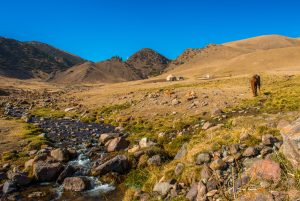According to a World Food Program forecast, the summer of 2021 was predicted to be much drier, hotter, and with little rainfall for the entire Central Asian region than previous years. The predictions were not far off the mark. Kazakhstan hit record temperatures in June, which delivered a devastating blow to its livestock. For Kyrgyzstan, the situation was just as grim. The National Statistical Committee of the Kyrgyz Republic has reported a 40 percent loss of rain-fed crop production in 2021 due to water scarcity and droughts. These numbers did not come as a surprise to anybody.
Kyrgyz farmers and agricultural workers had been sounding the alarm as early as June about water shortages and the increasing scarcity of rainfall. At first, they were met with a couple of patchy responses from the Ministry of Agriculture, one of them claiming that it was the farmers’ fault for engaging in agriculture that heavily relies on rainfall. After several organized pickets and protests were met with such dismissive responses, the farmers had nowhere else to turn but to try and tackle these problems by themselves.
Another group of people that have been left to solve the government’s issues by themselves are the workers at Kyrgyz water irrigation facilities. A visitor to one of the facilities in Kyrgyzstan today would be met with crumbling buildings, rusted machinery and equipment, moss and algae overgrowth, and the frustrated faces of disheartened workers doing what they can with the few resources they are provided with by the government. These facilities have seen better days, but those went with the Soviet Union. Kyrgyzstan has been left to maintain such facilities, but due to national budget constraints, it has proved to be impossible. Attempts have been made by the government, which is involved in various negotiations with inter-agency groups, to begin building new canals and wells, but it is uncertain when the planning and construction will actually begin.
Since most farms are fed through the irrigation systems (mainly canals for Kyrgyz farms) which receive their water from rainfall, rivers, and most importantly the melting of glaciers, ideal temperatures determine everything. Current temperatures barely reach the adequate level for the melting of glaciers in spring and rise so high in summer that the prospects of rainfall figuratively and literally dry up. Consequently, water feeding into the irrigation facilities is three times less than it was before.
The melting of glaciers has been a hot topic of discussion among environmental activists for a while since these glaciers are Kyrgyzstan’s main water resource. The worst-case scenario is that once those glaciers completely melt, mountainous Kyrgyzstan, which is basically a large reservoir distributing its water among the other Central Asian countries, will not be able to adequately sustain itself and scramble along with its neighbors to look for a resource elsewhere.
As the agricultural sector struggles with water shortages, the reported loss of rain-fed agricultural production in summer 2021 certainly raises the question of national food insecurity and more importantly the inflation of food prices as demand increases. The Kyrgyz government has responded to these concerns with a couple of solutions. The most important measure put forward was the import of 75,000 tonnes of wheat from Russia to make up for decreased production. Importing is certainly a solution, but it is a short-term one and unsustainable for the future. An overriding issue is the national budget, particularly how much and for how long it will allow Kyrgyzstan to import food to make up for lagging domestic production. Furthermore, Kyrgyzstan is still experiencing the economic aftermath of its COVID-19 lockdowns and disruptions to global supply chains. The national economy is still reconfiguring after the difficult period of 2020-2021, with the National Bank of the Kyrgyz Republic (NBKR) performing several interventions in order to keep the Kyrgyz som from losing value (which it did in 2020).
Water is often not regarded as a scarce resource in day-to-day life, but it should be. Agriculture being especially vulnerable to climate change, farmers and agricultural workers are witnessing first-hand the detrimental consequences of the government’s disregard for the rapidly changing and unpredictable temperature fluctuations. The repair and construction of canals and wells will not resolve the issue of water scarcity. The Kyrgyz government must urgently undertake the development of a national climate change plan and provide Kyrgyz farmers and agricultural workers with adequate mitigation measures to avoid the loss of their crops and livelihoods. Currently, the majority of the Kyrgyz citizenry might not see or experience the impending consequences of unaddressed climate change issues, particularly those of water scarcity, but what will happen when these issues eventually come knocking on one’s own front door?

































